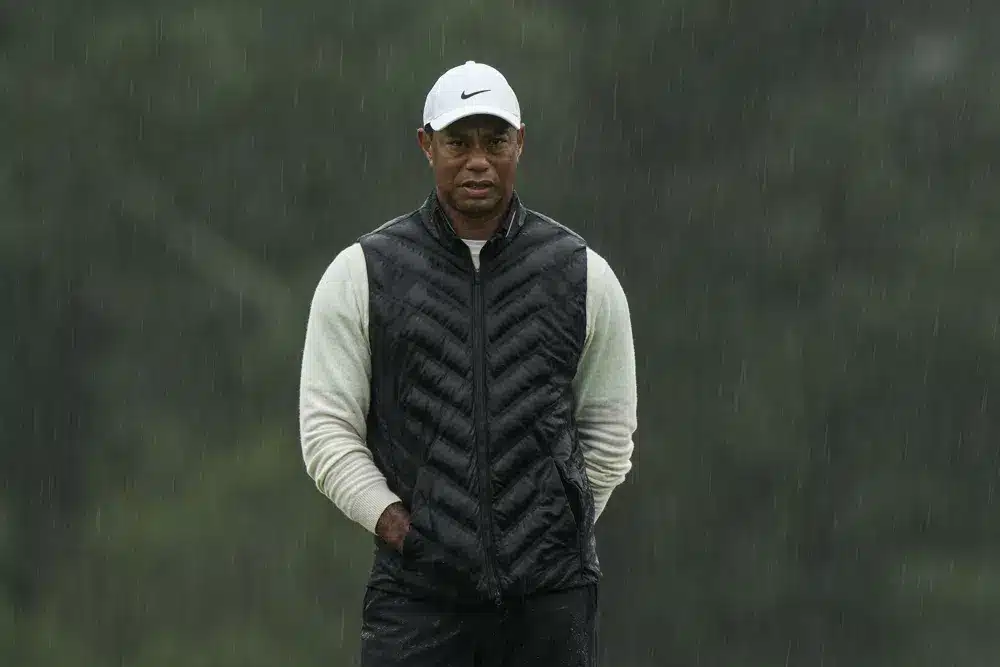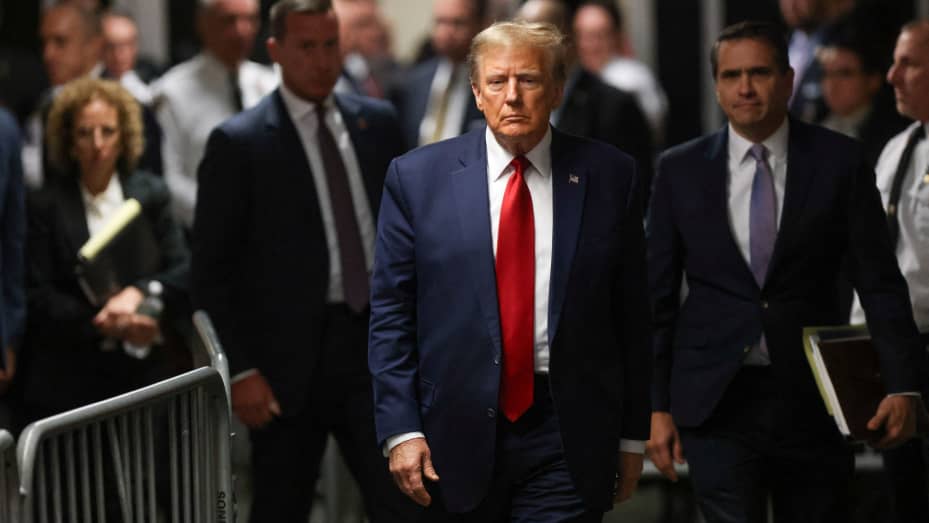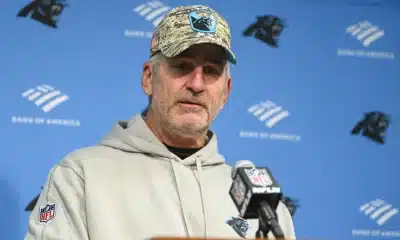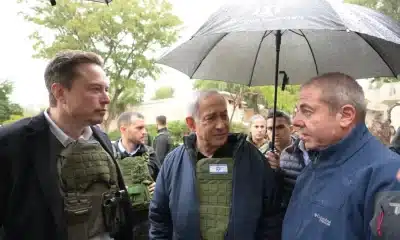News
Tiger Woods Has Ankle Surgery, Rest Of Majors In Doubt

Tiger Woods underwent fusion surgery on his right ankle Wednesday morning to relieve arthritis caused by a broken bone, casting questions on whether he will play any more majors this year.
Woods announced the operation on Twitter, stating that it was a subtalar fusion procedure to treat post-traumatic arthritis caused by a talus fracture in February 2021.
“He’s resting now and will start the recovery process,” said Mark Steinberg, his agent at Excel Sports, over the phone.
According to Steinberg, woods underwent surgery in New York and has now returned to his home near Jupiter, Florida, to begin rehabilitation.
When Woods could return to golf, Steinberg replied there was “no timetable on this.”
“The first goal is to recover and lead a much more enjoyable day-to-day life,” he explained.
In February 2021, Woods’ SUV fell off a suburban coastal Los Angeles road at roughly 85 mph and tumbled down the side of a hill, shattering many bones in his right leg and ankle. According to Woods, the injuries were so severe that physicians considered amputation.
As a result of the vehicle accident, Woods has undergone many surgeries on his leg. The ankle has been the source of most of his issues recently, including a perceptible limp when he competed in four of the last five majors, most recently the Masters two weeks ago.
When Woods could return to golf, Steinberg replied there was “no timetable on this.”
The talus is the second-largest bone in the tarsus group, which forms the lower half of the ankle joint and transfers body weight from the lower leg to the foot. The subtalar joint enables the side-to-side mobility required for walking, particularly on rough terrain.
According to most estimations, healing from subtalar fusion takes eight to twelve weeks. That would rule out the PGA Championship next month, which will be held at Oak Hill in Rochester, New York, and is expected to be frigid.
The United States Open will be held June 15-18 at Los Angeles Country Club, and the British Open will be held three months later (July 20-23) at Royal Liverpool in England.
Woods made an unlikely comeback 14 months after the automobile accident to play in the Masters, walking 72 holes. Despite withdrawing after three rounds of the PGA Championship last year and in the middle of the rain-delayed Masters this year, he only missed one cut – the British Open at St. Andrews last summer.
Woods cited plantar pain for his retirement from the Masters.
Woods cited plantar pain for his retirement from the Masters, where he tied a record with his 23rd cut. Plantar pain was also given as a reason for his withdrawal from the Hero World Challenge in the Bahamas in December, which he said was caused by working too hard to prepare for the event.
At the Masters, Jason Day stated that Woods informed him that the cause for his withdrawal from the PGA Championship last year “was a screw went through the skin.”
Woods previously underwent five back operations. This includes lower spine fusion surgery, which allowed him to return to play. He won the Tour event in 2018, the Masters in 2019 for his 15th major event, and the Zozo Championship in Japan in the autumn of 2019, tying Sam Snead’s career record of 82 PGA Tour titles.
In multiple interviews, he stated that the issue is not hitting shots but walking to the next one. Woods has also stated that his schedule will be limited to the majors and possibly others, such as the 36-hole PNC Championship with his son, where he can ride on a cart.
SOURCE – (AP)
U.K News
UN Calls For Investigation Into Mass Graves Uncovered At Two Gaza Hospitals Raided By Israel

The United Nations (U.N.) Gaza The United Nations has urged for a thorough and reliable investigation into the mass graves discovered at two prominent hospitals in war-ravaged Gaza, which were seized by Israeli troops.
According to U.N. spokesman Stephane Dujarric, credible investigators must be granted access to the locations. Additionally, Dujarric emphasized the importance of ensuring the safety of journalists in Gaza so that they may accurately report on the facts.
AP – VOR News Image
UN Calls For Investigation Into Mass Graves Uncovered At Two Gaza Hospitals Raided By Israel
Volker Türk, the U.N. human rights chief, expressed his deep shock at the destruction of the Shifa medical complex in Gaza City and Nasser Hospital in Khan Younis. He also mentioned the disturbing finding of mass graves in and around these facilities after the departure of the Israeli forces.
The individual demanded impartial and open inquiries into the fatalities, emphasizing that “considering the current atmosphere of exemption from punishment, this should involve investigators from the international community.”
“Hospitals are afforded significant protection under international humanitarian law,” Türk stated. “The deliberate act of killing civilians, detainees, and individuals who are unable to participate in combat is considered a war crime.”
Vedant Patel, the spokesperson for the U.S. State Department, expressed deep concern over the accusations of mass graves at the hospitals and confirmed that U.S. officials have formally requested information from the Israeli government.
The Israeli military has excavated the bodies that Palestinians had previously buried as part of their efforts to locate the remains of hostages taken by Hamas during their attack on October 7th, which initiated the war. The soldiers conducted a thorough examination of the bodies in a dignified manner and promptly returned those that did not belong to Israeli hostages to their original location.
The Israeli military asserts that it eliminated or apprehended numerous militants who had sought refuge within the two hospital complexes, although these assertions could not be independently confirmed.

CNN – VOR News Image
UN Calls For Investigation Into Mass Graves Uncovered At Two Gaza Hospitals Raided By Israel
On Monday, the Palestinian civil defense in the Gaza Strip said that they had discovered 283 corpses in a makeshift cemetery located within the primary hospital in Khan Younis. This cemetery was established during the recent period of Israeli forces surrounding the hospital. According to the group, during that period, individuals could not inter the deceased in a designated burial ground and instead excavated graves within the hospital premises.
According to the civil defense, certain corpses were identified as individuals who were slain during the hospital siege. Additional casualties occurred as a result of the Israeli military’s incursion into the hospital.
The hospital strikes have decimated Gaza’s health sector, which is already struggling to handle the increasing casualties resulting from more than six months of warfare, according to Palestinian health officials.
The matter of who is eligible or responsible for an investigation remains uncertain.
Dujarric stated that for the United Nations to carry out an investigation, authorization from one of its main bodies is required.
“I believe it is not appropriate for anyone to make premature judgments about the outcomes or the individuals responsible,” he stated. “I believe that the investigation should have both access and credibility.”
Karim Khan, the head prosecutor of the International Criminal Court, emphasized the importance of investigating any offenses committed by Hamas terrorists and Israeli forces during his visit to Israel and the West Bank in December.
According to Dujarric, the unearthing of the graves serves as an additional justification for implementing a cease-fire, resolving the conflict, ensuring increased humanitarian access and the delivery of essential products, providing enhanced protection for hospitals, and securing the release of Israeli prisoners.

NDTV – VOR News Image
UN Calls For Investigation Into Mass Graves Uncovered At Two Gaza Hospitals Raided By Israel
The Hamas assault that initiated the conflict resulted in the deaths of over 1,200 individuals, predominantly non-combatants, and the abduction of roughly 250 captives. Israel reports that the terrorists currently have approximately 100 hostages and the remains of over 30 additional individuals in their possession.
Local health authorities report that over 34,000 Palestinians have died as a result of Israel’s military campaign in Gaza to eradicate Hamas. Approximately two-thirds of the casualties are comprised of children and women. The devastation of Gaza’s two major cities has resulted in a humanitarian crisis, causing almost 80% of the population in the area to seek refuge in other sections of the besieged coastal enclave.
SOURCE – (AP)
News
April’s Pink Moon: When and Where to See It

Keep a watch on the skies tonight and tomorrow; you don’t want to miss the full pink moon, not the blue moon! According to The Old Farmer’s Almanac, you’ll get the best view about 7:49 p.m. ET.
This is when “peak illumination” occurs. As the full moon rises above the horizon, it will appear brightest and most vibrant to our eyes.
Where should you go to have the finest experience under the pink full moon? The Old Farmer’s Almanac suggests going somewhere with a good view of the open sky. If possible, attempt to select a location where the horizon is not covered by towering buildings or trees.
Although the pink moon will be a stunning sight to behold, it is not as colorful as it appears. It should appear rich amber at first, but it will fade to white as it rises into the night sky.
You may be wondering why it’s called a pink moon when it doesn’t look pink. According to USA now, many of the names we use for full moons now originate in much older Native American traditions. These names were mainly associated with natural events that month.
Pink Moon: Full Moon in April 2024
In April, Phlox subulata, often known as creeping phlox or moss phlox, began to flower. These rosy-hued petals were also known as “moss pink,” which is how the pink full moon got its name.
In February, we watched the snow moon rise in the sky. Last month brought the worm moon, which slightly less appetizing moniker refers to the presence of worms in nature during early spring.
According to Space.com, next month will see the floral moon. This May full moon is named after the abundance of blooms that will appear throughout this spring season.
A “pink moon” is an April full moon named for the early springtime blooms that paint landscapes in brilliant pinks and reds. It’s a celestial sight that signals nature’s rebirth after winter.
The pink hue is caused by sunlight refraction through the atmosphere, albeit it rarely seems that rosy tone.
Still, the name recalls the splendor of spring’s emergence, reminding us of the earth’s natural cycles. For many, the pink moon represents rejuvenation and new beginnings.
FIFA Nears $1 Billion Deal with Apple TV Plus
Politics
Trump Called This Visa ‘Very Bad’ For Americans. Truth Social Applied For One

MIAMI (AP) – The social media corporation established by ex-President Donald Trump has submitted an application for a business visa program that he aimed to limit during his tenure and that numerous of his supporters desire him to reduce if he were to serve a second term.
Trump Media & Technology Group, the company responsible for Truth Social, submitted an application in June 2022 for an H-1B visa for an employee earning an annual salary of $65,000, which is the minimum wage level permitted by the program. According to federal immigration data, the corporation received approval for a visa a few months after. The corporation asserts that it did not employ the worker.
AP – VOR News Image
Trump Called This Visa ‘Very Bad’ For Americans. Truth Social Applied For One
The act of applying for the visa highlights the contradiction between Trump the candidate, who has advocated for a protectionist approach that encourages corporations to prioritize American workers, and Trump the businessman, who has expressed his intention to utilize all available means for his companies. The investment firm established by Jared Kushner, who is both President Trump’s son-in-law and a White House adviser, submitted an application and received approval to employ a foreign individual as an associate through the visa program.
According to a statement from Trump Media & Technology Group, the application was submitted when the company was under previous management. However, it is worth noting that the current CEO, Devin Nunes, who was already leading the company, was involved in the application process when it was initially filed with the U.S. Department of Labor.
The company has never employed, and has no intentions of employing, a worker through the H-1B visa program. The company stated that upon discovering the application, which was submitted under a previous management period, the present management promptly halted the process in November 2022.
The cost for corporations to file an H-1B visa petition is approximately $5,000 per employee. Companies have the ability to retract applications even after they have been granted approval. The data maintained by the U.S. Citizenship and Immigration Services does not include information about visa revocations. However, a representative from the Labor Department, which also monitors H-1B applications, stated that they have no documented evidence of Truth Social submitting a request for withdrawal.
An ubiquitous instrument utilized by technology enterprises.
Technology companies frequently employ individuals through the H-1B program. Prior to assuming the presidency, Trump openly acknowledged his utilization of visas, mostly for the purpose of importing foreign models and a limited number of workers for his hotels and resorts. This information is based on an examination of the petitions filed since 2009.
However, apart from renewing current applications, his companies seemed to have ceased requesting H-1B visas until the creation of Truth Social.
According to the Labor Department, Trump Media & Technology Group submitted an application for an employee to receive a salary of $65,000. The employer is listed as Will Wilkerson, who is a co-founder of the company and a former senior vice president of operations. The employment is located in Atlanta, as indicated by the provided address.
In August 2022, Wilkerson submitted a whistleblower complaint to the U.S. Securities and Exchange Commission, accusing the corporation of committing securities breaches. He lost his job, and The Washington Post reported that he is now actively working with federal investigators. His legal representatives stated that he would refrain from providing any comments.
‘I should be prohibited from using it.’
Trump often discusses the influx of migrants who unlawfully cross the U.S.-Mexico border, but his policy agenda throughout his presidency also involved restrictions on legal immigration, such as family-based visas and the visa lottery program.
AP – VOR News Image
Trump Called This Visa ‘Very Bad’ For Americans. Truth Social Applied For One
During a primary debate in 2016, Trump expressed his disapproval of the H-1B visa program, describing it as both “very detrimental” and “inequitable” for American workers.
“To begin with, I possess extensive knowledge and understanding of the H-1B visa.” And it’s a tool that I frequently utilize, even though I should not have permission to do so. “We should not possess it,” he stated. “Furthermore, it is crucial to acknowledge that I am a businessman and I must prioritize my actions based on necessity.”
Three months into his presidency, Trump issued an executive order titled “Buy American and Hire American.” This order instructed Cabinet members to propose changes that would prioritize the allocation of H-1B visas to applicants who were either well paid or highly talented, with the aim of safeguarding American workers. He has previously asserted that the program was utilized by technology businesses to acquire overseas employees at a reduced salary.
Under his administration, a research conducted by the nonpartisan National Foundation for American Policy revealed that the government was intensifying its examination of cases by issuing additional information requests to companies seeking to employ foreign workers and rejecting a higher number of petitions.
The “Project 2025” handbook, created by supporters anticipating Trump’s potential assumption of power, suggests that the H-1B program should be restructured to function as an exclusive mechanism for attracting the most talented individuals at competitive wages, while also ensuring that American workers are not put at a disadvantage by the program.
Nicolas Morales, an economist specializing on labor and migration at the research department of the Federal Reserve Bank of Richmond, stated that over 60% of the total visas granted are attributed to companies in the professional, scientific, and technical services sectors. Morales stated that he has discovered that the visa program has proven advantageous for small enterprises in maintaining their operations.
Participating in and being selected in the H-1B lottery is advantageous for them. “It enhances their likelihood of survival,” he stated. “Over the next five years, small companies that heavily rely on skilled labor are expected to remain active.”
AP – VOR News Image
Trump Called This Visa ‘Very Bad’ For Americans. Truth Social Applied For One
The applications necessitate employers to affirm that they will furnish foreign workers with equivalent benefits as those provided to U.S. workers, and remunerate them at a higher rate than individuals with comparable expertise and qualifications, or above the standard wage for that particular occupation. Companies are required to notify their workers of the filing by displaying a notice in two locations at the workplace.
A significant portion of the criticism surrounding the H-1B program is to corporations providing foreign workers with salaries that fall under the lower wage brackets. The application submitted by Kushner’s investment firm to employ a foreign worker seems to address the allegation adequately.
The Labor Department approved a document in which Kushner’s investment firm stated that it would provide a salary of $200,000 to this employee. This amount falls inside the highest compensation range for H-1B visas, which are usually granted to individuals who are highly skilled in their industry and hold senior positions. According to recent data from U.S. Citizenship and Immigration Services, the company has been granted a visa approval.
Kushner has abstained from joining the Trump campaign and has been actively pursuing his own business ventures by submitting applications for tourism projects in the Balkans.
SOURCE – (AP)
-
News5 months ago
Death Toll From Flooding In Somalia Climbs To Nearly 100
-
Business5 months ago
Google Will Start Deleting ‘Inactive’ Accounts In December. Here’s What You Need To Know
-
Entertainment5 months ago
Merriam-Webster’s 2023 Word Of The Year Is ‘Authentic’
-
Sports5 months ago
Panthers Fire Frank Reich In His First Season With Team Off To NFL-Worst 1-10 Record
-
Celebrity5 months ago
Elon Musk Visits Destroyed Kibbutz and Meets Netanyahu in Wake of Antisemitic Post
-
Celebrity5 months ago
Shane MacGowan, Lead Singer Of The Pogues And A Laureate Of Booze And Beauty, Dies At Age 65














































